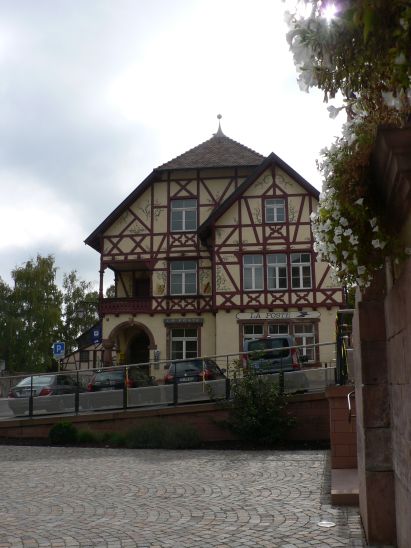Note the gray French sky. The bright blue of the past week sure struck us as atypical. But lovely.
The ornate building in the background is the Hotel de Ville, the town hall.
Then we took off for Riquewihr, which had been our destination of yesterday but for the overflow of other people with the same idea in mind. Today was much more manageable.
We can’t offer too very much in terms of interpretive prose, but the pictures and Sue Anne’s drawing will propel you right into the town. It was a lovely place, with most of the streets and structures as they were in the XVI century.
The vineyards are famous for their Riesling wines. We see the farmers bustling around all day with their picking equipment and yellow plastic bins full of pungent smelling green grapes.
This wasn’t our initial view of town, but it seems like a good representation of the entry way to our visit.
The Post Office with lovely floral painting on the stucco.
A 19th Century Postal Coach at the Museum of Communication
The vineyards at the edge of town
There’s lots of color in Alsace, and lots of apparent symbols of good luck.
Looking up the hill at the harvest in progress, with the camera set on 12x zoom.
The mechanized device at the right does seem to have pretty aggressive tires, but on a slope like this we would have expected pitons.
They all moved up the hill very quickly. We suspect that it might have been the second pass.
The view up the hill, as seen from in front of the Post Office. The pickers had reached the top by the time the drawing was finished.
Now back into town to check out the various offerings at the souvenir shops.
This is the famous Choucroute Garnie, sauerkraut with locally cured sausages piled up the side.
We haven’t yet tried any.
A tarte aux myrtilles is blueberry tart. In Canada the French word for blueberries is not myrtilles, but bluets. Above the choucroute is a bretzel.
A tarte aux myrtilles is blueberry tart. In Canada the French word for blueberries is not myrtilles, but bluets. Above the choucroute is a bretzel.
As noted earlier in the blog, the stork image is everywhere and is symbolic of fidelity and fertility. The storks winter as far away as South Africa. The couple returns to the same nest each year, the male arriving first to make repairs. There may be as many as 600 stork couples in Alsace. We would need to return earlier in the year to see the parents and the babies high on their rooftop nests, often situated in permanent facilities provided by the local government or the homeowners.
They come in all sizes.
Here’s ours. He doesn’t yet have a name. It has to be that Alsatian mix of a distinctly French first name coupled with a last name that it totally or almost completely German.
I’m thinking of a last name something like Dachswohner (roof dweller).
And that’s our Monday in Alsace.













No comments:
Post a Comment